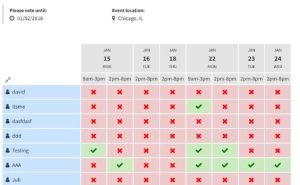What Is the Best Way to Schedule a Meeting With Multiple Attendees?
Utilize Scheduling Software To efficiently schedule a meeting with multiple attendees, utilizing digital scheduling tools is a must. Platforms like Doodle, Calendly, or Microsoft FindTime help streamline the process by allowing attendees to vote on preferred times, thus minimizing conflicts and eliminating the need for extensive emails. For example, Doodle’s 2021 survey found that 90% of its users saved up to two hours per week just by using the platform to schedule meetings.

Assess Attendee Availability Determining the best time for a meeting starts with understanding when your attendees are available. In organizations where calendars are shared, tools like Google Calendar or Outlook provide visibility into colleagues' schedules, helping you spot open slots quickly. This visibility is crucial, especially in large teams where finding a common free time without assistance can be like finding a needle in a haystack.
Prioritize Key Participants Identify who must be present for the meeting to be effective and schedule around their availability first. This tactic ensures that critical decisions or discussions are not postponed due to the absence of key individuals. According to leadership consultant Peter Drucker, the effectiveness of a meeting is largely dependent on having the right people present, emphasizing that not every meeting needs full attendance to be productive.
Set a Clear Objective and Agenda Once a time is set, immediately circulate a meeting agenda with defined objectives and expected outcomes. This not only prepares attendees but also keeps the meeting structured and focused. Statistics indicate that meetings with a predefined agenda are likely to be 40% more productive than those without.
Respect Time Zones For teams spread across different geographic locations, consider everyone's local working hours. Tools like Time Zone Ninja offer solutions to find optimal meeting times across the world. Ensuring that no participant has to attend meetings during unreasonable hours fosters goodwill and enhances productivity.
Send Reminders After scheduling, send reminders as the meeting approaches. A study by Atlassian pointed out that around 22% of scheduled meetings are missed annually due to attendees forgetting about them. Simple automated reminders can reduce this number significantly, ensuring high attendance and timely starts.
Review and Optimize After the meeting, solicit feedback on the scheduling process and the meeting efficiency itself. This feedback is vital for continuous improvement and can help refine future scheduling efforts.
In conclusion, finding what is the best way to schedule a meeting with multiple attendees involves strategic planning, the use of the right tools, and an understanding of attendees' needs. For more insights on crafting an inclusive and effective meeting schedule, check out this comprehensive guide: what is the best way to schedule a meeting with multiple attendees.
By implementing these strategies, you can streamline your meeting scheduling process, making it a less daunting and more productive endeavor.
